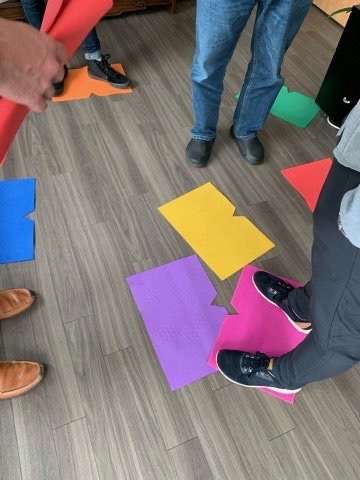UNDERSTANDING SEXUALITY THROUGH CONSTELLATION WORK
Is it possible to address sexual issues through the use of this tool? The answer is yes. There has already been someone who has dedicated to this subject – Ali Mezey, body therapist, Somatic counsellor, sexologist and constellation facilitator.
Recently at the AECFS – Asociación Española de Constelaciones Familiares y Sistémicas congress, which took place in Seville from 7 to 10 March 2024, Ali Mezey gave a brilliant workshop demonstrating her work, under the title “Constellations, Body and Sexuality”. I’ll come back to that in a moment.
Ali calls her work Personal Geometry®. As she explains, it is an approach that she developed based on family constellations and foundations developed by Bert Hellinger while integrating the knowledge of body approaches that she has deepened throughout her career as a body therapist and sexologist.
Using mats on the ground, Ali invites the client to draw a diagram of the problem-situation. The therapeutic work is based on a constant dialog between the spatial information contained in this diagram and the information that is being poured out through the client’s body. The visuo-spatial information is grasped intuitively and in constant reference to the bodily experience at the moment, and not understood in a purely intellectual way. The result is a gradual broadening of the understanding of the problem, the assimilation of its foundations, an apprehension of what is behind the initial image. The client actively appropriates his/her different parts, gaining progressive insight.
Using coloured post-its representing three elements – the heart, the genital organs and the person themself – Ali Mezey asked participants at the workshop to configure them on a sheet of A4 format paper. After this, she asked who wanted to present their personal diagram to the group, now using large coloured mats. It was interesting to see the large number of participants who resolutely offered to do so. The large room was filled with colourful triads.
But reality took Ali in an unexpected direction: when she approached the first participant who was willing to explore his diagram, he ended up being the only one Ali worked with. Faced with the sensitivity manifested by this participant, testimony of his urgency, openness and willingness to be touched by a therapeutic work, Ali could no longer take her attention off him.
Because of this we all had the opportunity to witness Ali conducting a complete session.
The participants, mainly therapists and psychotherapists, were captivated and seduced by her subtle and precise way of treating the situation, by the way she helped the client to overcome his own defensive strategies, cleverly bypassing them until penetrating the embodied information. It was an intense, surgical and delicate work. The serenity achieved by the patient testified to this..
How does such a simple-looking exercise in a short space of time can reach such depth? Ali Mezey carries out a rigorous transduction of the information from the client’s system, diagramed in space, manifested through the body, emotions, and words, scrupulously respecting the rhythm of her client’s revelations. In resonance with the client, and in permanent body-to-body listening.
Feeling brings your mind into your matter, and your mind brings your awareness to feeling – a phrase taken from her website – that is the fertile process where transformation lies.
Her approach has been used with good therapeutic results in cases of anorgasmia, erectile dysfunction, difficulties with gender identity, trauma and sexual abuse, but also with issues such as dysmorphia and eating disorders. Cases of addiction, particularly to sex and drugs, have also been treated successfully, as this method proves to be suitable for patients who are in a more dissociated state, disconnected from their emotions or desensitized from their bodies.
But reality took me by surprise, too. Simultaneous translation using artificial intelligence, presented as a hopeful novelty at this congress, proved to be ineffective and caused a lot of dissatisfaction. So it was necessary to improvise a consecutive translation – neither prepared nor planned – from American English into Spanish, by a Portuguese woman who is not a professional translator, nor has she ever done such a task, especially at an international congress!
I would also like to mention Ali Mezey’s contribution to the round table entitled “Further work after a constellation?”, which I myself moderated.
The aim of this panel was to listen to the opinions of experienced psychotherapists on the following question: are constellations interventions of a single session or does the client need further work to integrate the images that their constellation has revealed? I’ll return to this topic at a later date with further extension.
Ali Mezey stated that constellation work makes it easier to overcome egoic defenses and narratives that support the problem. And this potentiality can be used to access embodied information, boosting the therapeutic process in a more penetrating and rapid way than conventional therapies. She concluded by saying that ideally, professionals in these therapies could agree to be partners with those who facilitate constellations, resulting in significant gains for clients.
Eva Jacinto
26-03-2024



